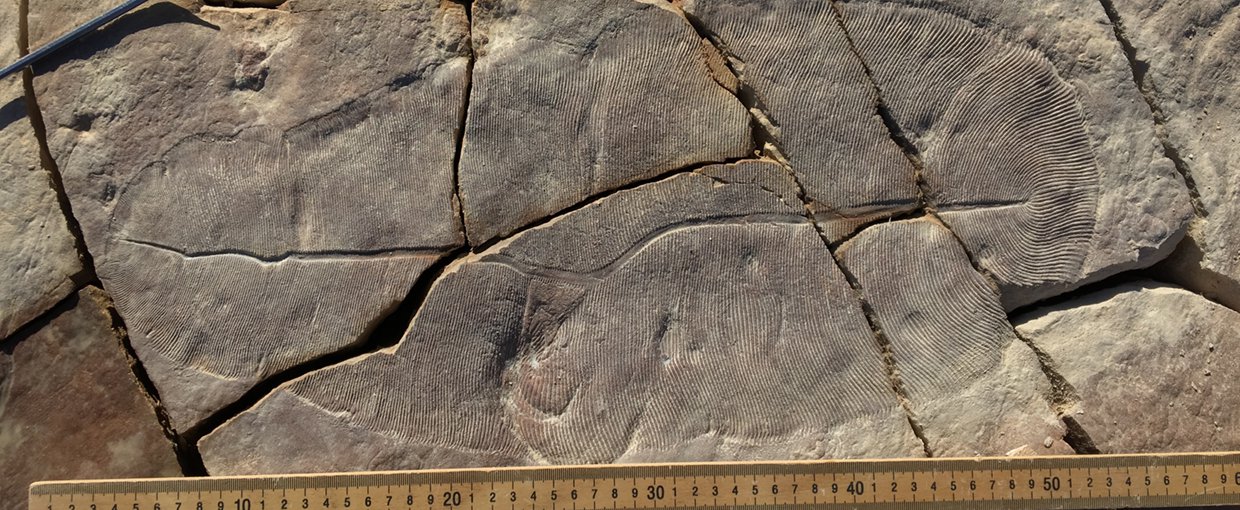
Deep within the largest mountain range in South Australia lies a formation that holds one of the most important records of geological history on Earth. Astrobiologists and other researchers have studied this region for decades to gather insights about the history of our planet, including an important transitional period in the evolution of life. In 2021, the South Australian government made the decision to designate the area as a National Park in order to safeguard its cultural and scientific heritage. Now, the facilities of Niplena Ediacara National Park have opened, providing scientists and the public with access to one of Earth’s true geological treasures.

The Nilpena fossil site in South Australia from above.Image credit: Department for Environment and Water, South Australia.
A National Park for Science
Our planet’s geologic record holds invaluable information about the origins and diversification of life on Earth. Studying this record helps astrobiologists better understand the habitability of our planet, how the Earth has changed over time, and the evolution of life in response to the environment. Understanding the coevolution of life and the Earth also provides important clues about the potential for life on other worlds in the Universe.
The rocky outcrops of Nilpena hold evidence of ancient life on Earth from the end of the Ediacaran Period, which lasted between 574 to 539 million years ago. These windows into Earth’s past show the Ediacara biota, a collective term for the population of creatures that survived during this crucial time in Earth’s history. These early macroscopic, multicellular organisms represent a period of time when, through evolution and diversification, the first animals were exploring a range of forms. Scientists are studying beds of fossils found in this region in order to reconstruct the chronological timeline of the emergence of animal life on Earth (1).
“The NASA Astrobiology Program values this type of research because it informs our understanding of the evolutionary trajectory of the complexity of life on Earth, which is ultimately important for understanding how life co-evolves with a habitable planet over time,” explains Lindsay Hays, Program Officer for the Exobiology research program and Deputy Program Scientist for the NASA Astrobiology program. “Prof. Droser’s work has been funded by multiple sequential Exobiology program awards as this research has progressed.”
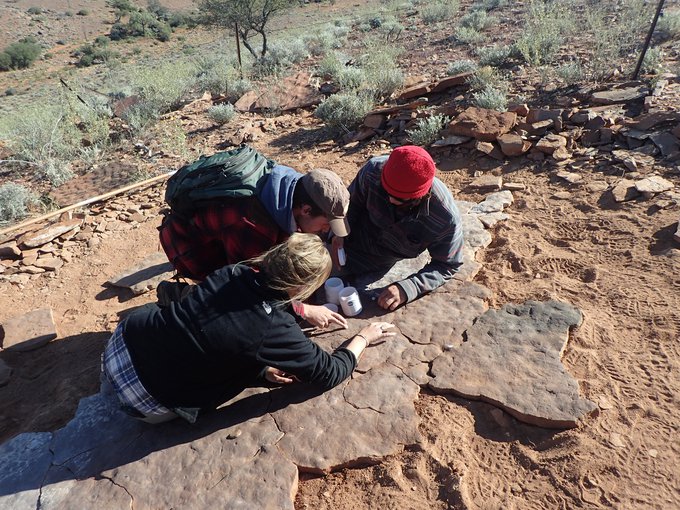
The research team at a site dubbed Alice's Restaurant Bed, which is the showcase of the new audiovisual experience at Niplena Ediacara National Park. Pictured left to right: Emmy Hughes, a Ph.D. student at the Georgia Institute of Technology studying brines on Mars, Dr. Peter Dzaugis (Colorado Childrens Hospital), and Scott Evans (Florida State University), a former NASA Future Investigators in NASA Earth and Space Science and Technology (FINESST) fellow.Image credit: Courtesy of Mary Droser, UCR.
For over 20 years, NASA has supported scientists who are helping to reconstruct this timeline. Professor Mary Droser, a paleontologist at the University of California at Riverside, and her team have made multiple trips to the region to explore this incredible cache of fossils. What sets the Nilpena site apart from other locations of Ediacara fossils on Earth is the way in which they have been preserved and the relative ease at which they can be accessed.
“Imagine these organisms living on the seafloor, and then a storm comes in and dumps a bunch of sand on top of them,” explains Droser. “This sand helped preserve the microbial mats, the geology, and an assortment of features in discrete layers over geological time. This allows us to excavate a succession of sandstone beds with these organisms in situ.”
Over the years, Droser’s team has excavated around forty of these fossil beds, each of which provides a specific and different window into the past.
“The ability to excavate these beds is unique in South Australia,” says Droser. “We are literally able to excavate bed on top of bed and get snapshots of Earth’s history. And we are able to do this over hundreds of square meters of the seafloor.”
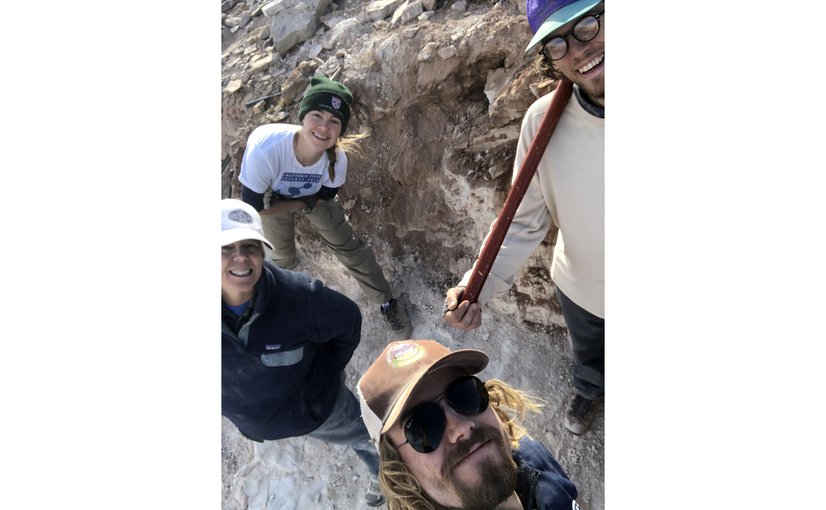
Mary Droser (far left) with her team standing in a pit excavating one of the Nilpena fossil beds.Image credit: Courtesy Mary Droser, UCR.
Digging down through the distinct layers of preserved organisms has allowed scientists to observe the dawn of active mobility in life, a time when organisms began moving around under their own power and not simply sessile on the seafloor.
“The site shows an extraordinary burst of diversity and morphological disparity,” says Droser. “What we get in Nilpena is starting to look familiar compared to life we see today. The beds are littered with the soft bodied organisms and there is evidence of different ways of reproducing, like sexual reproduction. Simply put, this is the best record of the dawn of animal life on Earth.”
Nilpena has also been a testbed for developing NASA technology, such as instruments for robotic space missions to locations like Mars, and the selection of landing and sample sites on the red planet. One example is the development of software that was able to identify biosignatures in photographs of rock cross-sections from Nilpena (2). The “Scene-aware Perception Automation using Composite Embedding for Segmentation” (SPACESeg) was used to spot shapes in the rock dubbed “Double-Rippled” bedforms (DRBs). These features were formed with the help of organic mats that covered the ancient seafloor in this location and shaped the physical appearance of the rocks that were preserved. The mats stabilized ripples on the seafloor, preventing erosion of the ripple features (3). Those ripples were then preserved as the sediments settled on the seafloor and ultimately created discrete signatures in the rock (e.g. the DRBs).
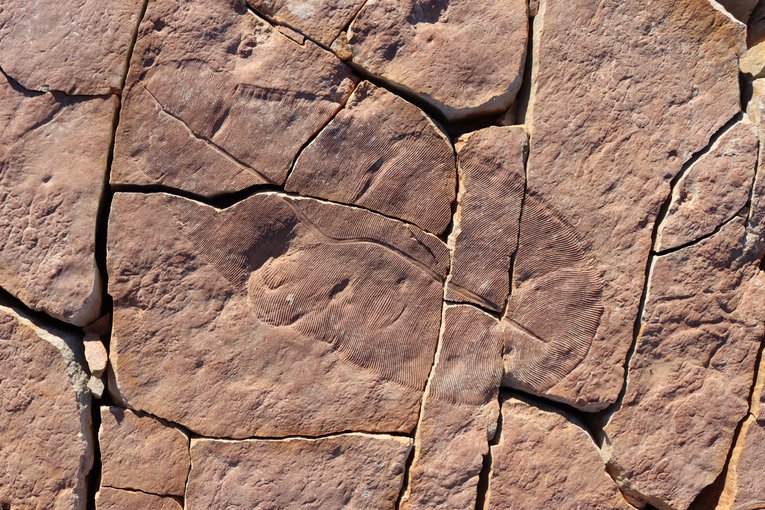
A Dickinsonia fossil from the Nilpena site in South Australia.Image credit: Mary Droser, UCR.
Building a National Park
In 1946, the first fossils in the region were identified in a location known as the Ediacaran Hills. This discovery generated public interest and over time visitors began to arrive, including scientists, tourists, and amateur fossil enthusiasts. The influx of traffic resulted in damage to the site that threatened its cultural heritage, environmental stability, and scientific integrity. Because of this, the Ediacara Conservation park was formed on April 26, 2007, to preserve the scientific value, aboriginal history, early mining history, and the natural environment and the animals that call this location home (3).
The Nilpena fossil beds are located south of this original site and to the west of the Flinders Ranges, some 600 kilometers (370 miles) north of Adelaide, South Australia’s capital and largest city. The fossils were discovered by Nilpena land owner and pastoralist Ross Fargher, who recognized the need to protect the site. Through his efforts, Nilpena was spared from much of the impact experienced at the Ediacara Hills site. Fargher was awarded the Strimple Award by The Paleontological Society in 2017 for his efforts to preserve Nilpena, and was the first person in the southern hemisphere to receive the honor.

An image of a Spriggina floundersi fossil. Fossils of these organisms only occur in South Australia and are the official state fossil of South Australia.Image credit: Mary Droser, UCR.
In March of 2019, the South Australia state government purchased 60,000 hectares (over 230 square miles) from the Nilpena Pastoral Company and acquired the land on which the Nilpena fossil site resides. This purchase connected the existing Ediacara Conservation park with the Lake Torrens National Park. On June 17, 2021, the entire area was reclassified to become Nilpena Ediacara National Park and efforts began to develop the facilities and infrastructure.
The park now houses the Nilpena visitor hub, which includes a fossil experience for those interested in the astrobiological significance of the research being conducted here. When visiting the fossil field, visitors are led on guided tours across paths, elevated boardwalks, and viewing platforms. The new facilities will help protect the site for future scientists and visitors alike.
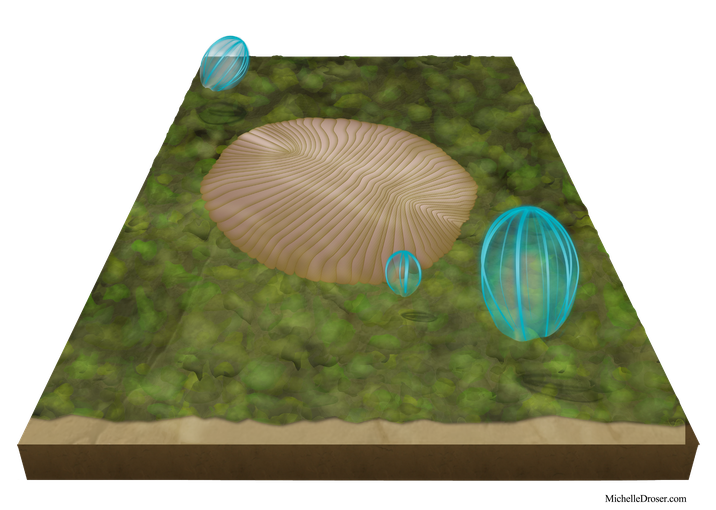
This model illustration shows Attenborites, fossils of an organism that is the first (as far as we know from the fossils record) macroscopic organism to be in the water column. Above the green microbial mat base float possible reconstructions of the organism itself.Image credit: Courtesy of Mary Droser, UCR.
The newly opened Niplena Ediacara National Park is also one of seven sites across the Flinders Ranges that are currently included in a bid for World Heritage status from the United Nations Educational, Scientific and Cultural Organisation (UNESCO).
“Nilpena is one of the greatest fossil sites of any age,” says Droser. “Imagine how cool it is that one of the greatest fossil sites of all time is preserving the dawn of animal life… the first time that animals are in the water column, the first time that animals are moving, the first time a number of these organisms are reproducing sexually.”
“When you think about how we are able to go back in time and pull apart these moments in the advent and evolution of life on our planet,” Droser continues, “it’s just extraordinary. Earth is the only planet we know of with life and we need to understand its history here.”
Droser and her colleagues participated in early talks about the importance of the site and its legacy to South Australia. Their efforts gained support from the government and local communities.
“Early on this was a sheep station, and we knew the only way to preserve these hundreds of thousands of fossils would be to have it open to the public,” says Droser.
The team of researchers became intimately involved in helping to establish the national park and have directly participated in aspects of its design, including the designation of paths through the area and the stabilization of fossil beds to limit the impact of visitors.
When asked about the importance of the national park designation to her and her team, Droser explained, “It’s over 20 years of research, largely supported by NASA grants. The protection of this site is so important, and I wouldn’t miss it for the world.”

A lizard rests near an example of a Parvancoria fossil at the Nilpena site.Image credit: Courtesy of Mary Droser, UCR.
A National Park for Culture
The Nilpena Ediacara National Park sits on the traditional lands of the Adnyamathanha people in what is now the state of South Australia. In fact, the geological Ediacaran Period derives its name from the Adnyamathanha language (4).
The cultural heritage of the site is and has been an important consideration for the science being performed there and the need to preserve the landscape. Droser and her team have worked with the local community, which is largely Adnyamathanha, to bring school groups and other community members along with them on their scientific exploration. These visits have provided opportunities to share knowledge and dialogue about the importance of the fossil beds, and have allowed the scientific team to spend time with community members and elders to learn about the Adnyamathanha history of the area.
“This is traditional Adnyamathanha land, and that is an important part of the story,” says Droser. “In creating this national park, you have this amazing coming together of government, scientists, community groups, and pastoralists. It has been a really interesting experience, and a really positive experience.”

Mary Droser at the Nilpena site in South Australia.Image credit: Mary Droser, UCR.
Nilpena National Park offers astrobiologists an invaluable window into the history and evolution of life on Earth. The data gathered from the site has helped scientists understand the interconnections between life and the planet through a crucial period of Earth’s history. The dedication of the new national park recognizes the importance of the site and will help preserve it so that future generations can continue to learn from this unique resource.
“It’s a one off. There is no other Nilpena in the world. It is important to go to the public and say, this is what the Earth looked like. I can write as many papers as I want,” says Droser, “but, honestly, having a national park where people come and learn about these kinds of things is a greater legacy and we want to do it right.”
The state government of South Australia acknowledges Aboriginal people as the First People and Nations of the lands and waters we live and work upon and we pay our respects to their Elder past, present, and emerging. We acknowledge and respect the deep spiritual connection and the relationship that Aboriginal and Torres Strait Islander people have to Country. We work in partnership with the First Peoples of South Australia and support their Nations to take a leading role in caring for their Country.
References:
- Boan, P.C., Evans, S.D., Hall, C.M.S., Droser, M.L. (2023) Spatial distributions of Tribrachidium, Rugoconites, and Obamus from the Ediacara Member (Rawnsley Quartzite), South Australia. Paleobiology. DOI: 10.1017/pab.2023.9
- Jonnalagedda, P. et. al. (2022) Automated Remote Biosignature Detection using Modified SPACESeg Model. 53rd Lunar and Planetary Science Conference. Exobiology Funding.
- Tarhan, L.G., et. al. (2017) Palaios, 32(3):181-194. Microbial mat sandwiches and other anactualistic sedimentary features of the Ediacara Member (Rawnsley Quartzite, South Australia): Implications for interpretation of the Ediacaran sedimentary record. Palaios, 32(3):181-194. DOI: 10.2110/palo.2016.060
- Ediacara Conservation Park management plan (2012) Adelaide: South Australia. Department of Environment, Water and Natural Resources, available from https://www.environment.sa.gov.au/
- National Parks and Wildlife Service, South Australia (2023) https://www.parks.sa.gov.au/
Related Links:
New Australian National Park Protects Site Important to NASA Research
Crossing the Boundary of the Ediacaran and the Cambrian
Environments that Allowed Ediacara Biota to Flourish
A View to the Late Ediacaran
Nilpena Ediacara National Park
Australian Center for Astrobiology
Earth’s Oldest Bilaterian
Scientists Explore Outback as Testbed for Mars (Mars Exploration Program)
Potential Biomarkers in Planetary Analog Brine Environments: Project Report
The Western Australia Astrobiology Grand Tour
Early Career Astrobiologists Explore Ancient Life



